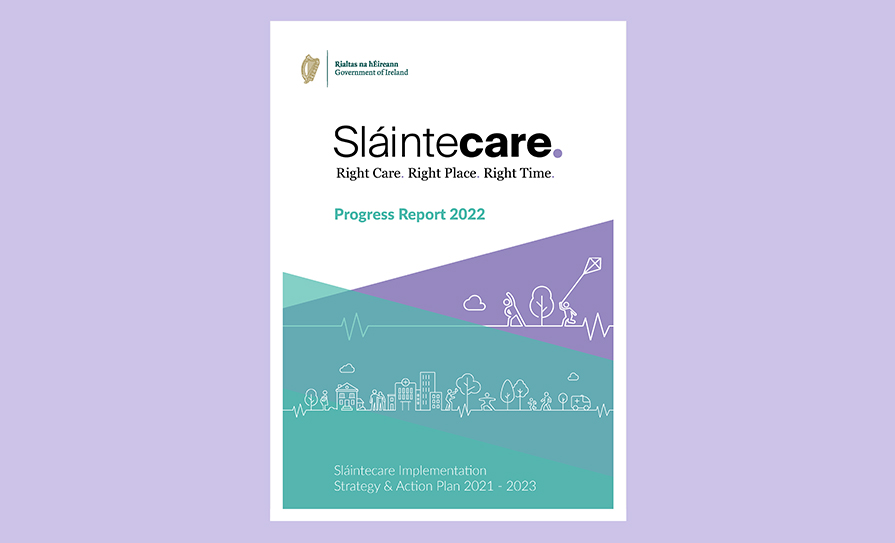The ‘Sláintecare Progress Report 2022’ offers an opportunity to see how far, or otherwise,
the Government’s central health strategy is advancing. David Lynch reports
In 2017, the Oireachtas committee on the future of healthcare published the Sláintecare health reform report with cross-party support. Last summer marked five years since the publication of the decade-long health strategy.
In late March this year, the Department of Health published both the Sláintecare Progress Report 2022 and the Sláintecare Action Plan 2023.
As Sláintecare touches on nearly every aspect of the health service, the reports are comprehensive at 92 and 41 pages respectively. The progress report contains a detailed appendix, which outlines the 120 ‘Sláintecare deliverables status by project’. Because of its wide range, this appendix works as an extensive snapshot of policy progress across the entire health service.
It outlines that 100 of the 120 projects (83.3 per cent) were delivered or have progressed as planned or with minor delays.
Delays
A complete breakdown shows that 35 projects are ‘on track’ (29 per cent); 35 projects are ‘complete’ (29 per cent); 23 projects have a ‘minor delay’ (19 per cent); 16 projects have a ‘significant delay’ (13 per cent); seven have been ‘completed later than planned’ (6 per cent); while four had a ‘significant delay due to external dependency’ (3 per cent).
Some of the projects facing a ‘significant delay’ include the finalisation of a new National Physical Activity Plan (NPAP). This delay was first reported in the Medical Independent (MI) in April 2022. The progress report notes that “due to the prioritisation of the development and launch of the free contraception scheme, development of the new NPAP had to be deferred and will now be finalised in quarter four, 2023”.
There has also been a significant delay with the publication of an adult safeguarding policy. “The draft policy required more substantial revisions than anticipated following steering group feedback,” according to the progress report.
Also, the promise to develop a policy paper on the future direction of long-term residential care infrastructure and financial sustainability has been “paused”.
“Scoping work has commenced on the development of this paper; however, this project is now paused. Immediate sustainability concerns must be addressed as a priority, therefore, resources have been reallocated accordingly.”
Progress
In his foreword to the report, Minister for Health Stephen Donnelly focuses on what he regards as areas of clear progress, such as the approval of the new elective-only hospitals in Cork, Galway, and Dublin.
“This will change the way in which day cases, scheduled procedures, surgeries, scans, and outpatient services are arranged, across the country,” states Minister Donnelly. “These hospitals will ensure greater elective capacity in the future, protect scheduled care capacity, and support a reduction in waiting times.”
The preferred sites recommended for the planning phase are at St Stephen’s Hospital, Sarsfield Court in Cork, and Merlin Park University Hospital in Galway.
The HSE informed MI that development of the preliminary business case for the Dublin site, which includes a site identification exercise, was ongoing.
RHAs
In his foreword, Minister Donnelly also cites “real progress” on the regional health areas (RHAs), highlighting the forthcoming publication of the implementation plan. In primary care, Minister Donnelly notes that “over 2,400 healthcare workers were recruited to the enhanced community care programme”. Also, the abolition of inpatient hospital charges for children under 16 years, the introduction of free contraception for women, the reduction in drug payment thresholds, and the planned extension of free GP visits in 2023 to almost half the population, all represent progress towards the “Sláintecare vision”, writes
the Minister.
With the extensive range of areas covered by Sláintecare, it is sometimes easy to lose focus on what is the overarching vision.
According to the Minister, the strategy goal is a “single-tier health and social care service and ensuring equal access to services based on patient need and not ability to pay”.
Contract
It is no surprise that the new consultant contract features prominently within the progress report. MI reported last July that the previous Sláintecare Action Plan 2022 stated that the “core principle” of removing private healthcare from public hospitals was “subject to agreement with representative bodies on the introduction of the Sláintecare contract”.
A new contract is now being rolled out. However, as reported in recent editions of this newspaper, the response from IMO and IHCA members has been far from enthusiastic.
The progress report emphasises that the new contract will not just lead to the removal of private care from public hospitals, but will also significantly alter the role consultants play in the delivery of care.
The new contract will “ensure there are more senior decision-makers in our hospitals out-of-hours and at weekends” according to the report. This will benefit public patients by ensuring “a significantly greater consultant on-site presence”. However, despite the new contract, medical representative bodies have continued to highlight concerns regarding onerous rosters and the need to employ additional consultants.
Waiting lists
While the report, as the title suggests, focuses on progress, there are also pages devoted to the serious ‘challenges’ facing implementation.
The progress report concedes that acute hospital scheduled care waiting lists “are far too long, and that many patients are waiting an unacceptably long time for care”. These lists “worsened considerably during the Covid-19 pandemic, and health services are now dealing with significant pent-up” demand.
The Department claims that; despite these challenges, “positive progress has been made in Ireland over the past 18 months” due to new multi-annual waiting list action plans.
The report states this new approach “is turning the tide on rising waiting lists and waiting times”.
“Waiting lists for scheduled care in our hospitals increased by nearly 60 per cent between 2015 and 2021 creating huge backlogs, but this unacceptable trend has now been halted and waiting lists and waiting times are now decreasing as a result of the interventions funded by our annual action plans.”
However, one of the four initiatives to experience a “significant delay due to external dependency” was the complete implementation of the 2022 Waiting List Action Plan (WLAP).
“Significant reform actions in the 2022 WLAP were intended to be progressed in tandem with delivering extra activity,” according to the report.
“However, recurrent funding was deemed required to deliver key reform actions in the coming years, including sustainably resolving capacity gaps and implementing the modernising of 37 acute scheduled care pathways. €123 million was included in Budget 2023 and the HSE is progressing planning for the implementation of these care pathways on this basis. Details have been included in the 2023 WLAP, published in quarter one, 2023.”
Recruitment
The recruitment and retention of staff remains a significant threat to the successful implementation of Sláintecare. The Department admits that a “paradigm shift is required to address the challenges we face both domestically and globally in relation to the supply of healthcare workers”. The progress report notes there are “significant challenges” recruiting clinical staff, highlighting that the World Health Organisation estimates a projected global shortfall of 10 million health workers by 2030.
“The problem is further compounded by the high percentage of our health workforce aged over 55 years.”
According to the report, currently, 22 per cent of doctors, 27 per cent of dentists, and 22.5 per cent of pharmacists are aged over 55 years and will be approaching retirement, on average, in the next 10 years.
“To address this issue, we need to significantly increase the number of training places available to Irish and EU students to study medicine, nursing, and health and social care professional courses, in order to increase the domestic supply of doctors, nurses, and health and social care professionals to work in our health service.”
2023
The Sláintecare Action Plan 2023 outlines the aims for the final nine months of the year.
According to the action plan, the remainder of the year will see a major focus on a number of areas, including the RHAs, the 2023 Waiting List Action Plan and the development of the elective hospitals.













Leave a Reply
You must be logged in to post a comment.